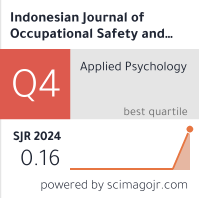The Relationship Between Mental Workload and Sleep Quantity with Work Fatigue among Haul Dump Truck Operators in Coal Mining

Downloads
Introduction: In mining production activities, haul dump trucks are utilized for transportation purposes and are driven by an operator. The haul dump truck operator works in a shift work system consisting of 12 working hours. The workers are required to always control the steering speed, causing potential work fatigue. This study aimed to analyze the relationship between mental workload and sleep quantity with work fatigue among haul dump truck operators. Method: This study was a quantitative research study using a cross-sectional design. The population was 179 haul dump trucks operators, while the sample was 123 respondents determined through simple random sampling. The variables of this study were age, years of service, education level, mental workload, sleep quantity, and work fatigue complaints. The data was tested using the Chi-Square test. The instruments used to obtain the data were the National Aeronautics and Space Administration Task Load Index and the Work Fatigue Measurement Tool Questionnaire. Result: The haul dump truck operators (54.5%) had a high mental workload, low sleep quantity (61.8%) with less than 7 hours of sleep, and moderate fatigue complaints (44.7%). There was a significant relationship found between age (P-value = 0.018), years of service (P-value = 0.039), and sleep quantity (P-value = 0.001) with work fatigue complaints. The level of education and mental workload had a significance value above 0.05. Conclusion: Sleep quantity has a significant relationship with work fatigue complaints. This can be responded to by intensifying the information on the socialization of fatigue and the importance of maintaining the quality of sleep.
Arifin, Z. and Wati, E. (2020) ‘Hubungan Kualitas Tidur Dengan Konsentrasi Belajar Pada Mahasiswa Keperawatan Universitas Muhammadiyah Purwokerto', Human Care Journal, 5(3), pp. 650-660.
Budiono, A. M. S., Jusuf, R. M. S. and Pusparini, A. (2016) Bunga Rampai Hiperkes & KK : Higiene Perusahaan, Ergonomi, Kesehatan Kerja, Keselamatan Kerja. Revisi. Semarang: Badan Penerbit Universitas Diponegoro Semarang.
Caesarridha, D. K. (2021) ‘Hubungan Kualitas Tidur Dengan Konsentrasi Belajar Pada Mahasiswa Fakultas Kedokteran Di Masa Pandemi Covid-19', Jurnal Medika Hutama, 2(4), pp. 1213–1217.
Caldwell, J. A. et al. (2019) ‘Fatigue and its Management in the Workplace', Neuroscience and Biobehavioral Reviews, 96(2019), pp. 272–289.
Cham, B. S. et al. (2021) ‘Investigating the Joint Effects of Overload and Underload on Chronic Fatigue and Wellbeing', International Journal of Work, Health, and Organisations, 35(3), pp. 1–14.
Djamaludin, D., Safriany, R. and Sari, R. Y. (2021) ‘Pengaruh Breathing Exercise Terhadap Level Fatigue Pasien Hemodialisis', Malahayati Nursing Journal, 3(1), pp. 72–81.
Elwindra, E. and Rizal, M. (2019) ‘Faktor-Faktor yang Berhubungan dengan Kelelahan Kerja pada Pengendara Ojek Online di Jakarta Timur Tahun 2018', Jurnal Persada Husada Indonesia, 6(21), pp. 1–8.
Engberg, I. et al. (2017) ‘Fatigue in the General Population- Associations to Age, Sex, Socioeconomic Status, Physical Activity, Sitting Time and Self-Rated Health: the Northern Sweden MONICA Study 2014', BMC Public Health, 17(1), pp. 1–9.
Fenny, F. and Supriatmo, S. (2016) ‘Hubungan Kualitas dan Kuantitas Tidur dengan Prestasi Belajar pada Mahasiswa Fakultas Kedokteran', Jurnal Pendidikan Kedokteran Indonesia: The Indonesian Journal of Medical Education, 5(3), pp. 140-147.
Friedman, L. S., Almberg, K. S. and Cohen, R. A. (2019) ‘Injuries Associated with Long Working Hours among Employees in the US Mining Industry: Risk Factors and Adverse Outcomes', Occupational and Environmental Medicine, 76(6), pp. 389–395.
Härmä, M. et al. (2019) ‘Shift Work with and Without Night Work as a Risk Factor for Fatigue and Changes in Sleep Length: A Cohort Study with Linkage to Records on Daily Working Hours', Journal of Sleep Research, 28(3), pp. 1–9.
Hidayanti, R. C. and Sumaryono, S. (2021) ‘The Role of Sleep Quality as Mediator of Relationship between Workload and Work Fatigue in Mining Workers', Jurnal Psikologi, 48(1), p. 62.
Innah, M. et al. (2021) ‘Faktor Yang Berhubungan Dengan Kelelahan Kerja Pada Penjahit Pasar Sentral Bulukumba', Window of Public Health Journal, 1(5), pp. 471–481.
Juliana, M., Camelia, A. and Rahmiwati, A. (2018) ‘Analisis Faktor Risiko Kelelahan Kerja pada Karyawan Bagian Produksi PT. Arwana Anugrah Keramik, Tbk', Jurnal Ilmu Kesehatan Masyarakat, 9(1), pp. 53–63.
Kristiawan, R. (2018) ‘Faktor Penyebab terjadinya Kecelakaan Kerja pada Area Penambangan Batu Kapur Unit Alat Berat PT. Semen Padang.', Jurnal Bina Tambang, 5(2), pp. 11–21.
Kurnianto, D. (2015) ‘Menjaga Kesehatan Di Usia Lanjut', Jurnal Olahraga Prestasi, 11(2), p. 115182.
Malik, I., Hardi, I. and Abbas, H. H. (2021) ‘Faktor yang Berhubungan dengan Kelelahan Kerja di PT. Industri Kapal Indonesia (Persero) Makassar', Window of Public Health Journal, 1(5), pp. 580–589.
Minarna, F. M. (2018) ‘Hubungan Antara Faktor Individu Dan Beban Kerja Mental Dengan Keluhan Kelelahan Kerja Pada Pengemudi Haul Dumptruck', Journal of Community Mental Health and Public Policy, 1(1), pp. 1–12.
Narpati, J. R., Ekawati and Wahyuni, I. (2019) ‘Hubungan Beban Kerja Fisik, Frekuensi Olahraga, Lama Tidur, Waktu Istirahat Dan Waktu Kerja Dengan Kelelahan Kerja (Studi Kasus Pada Pekerja Laundry Bagian Produksi Di CV. X Tembalang, Semarang)', Jurnal Kesehatan Masyarakat, 7(1), pp. 337–344.
Nurdiawati, E. and Safira, R. A. D. (2020) ‘Hubungan antara Keluhan Kelelahan Subjektif, Umur dan Masa Kerja terhadap Produktivitas Kerja pada Pekerja', Faletehan Health Journal, 7(2), pp. 113–118.
Pepin, E. et al. (2018) ‘Shift Work, Night Work and Sleep Disorders among Pastry Cookers and Shopkeepers in France: A Cross-ectional Survey', BMJ Open, 8(5), pp. 1–12.
Rahmawati, N. D. and Tualeka, A. R. (2019) ‘Correlation between Individual Characteristics, Workload, and Noise with Work Fatigue', The Indonesian Journal of Occupational Safety and Health, 8(2), pp. 139-149.
Rizal, M., Afrianti, R. and Abdurahman, I. (2021) ‘Dampak Kebijakan Pemberlakuan Pembatasan Kegiatan Masyarakat ( PPKM ) bagi Pelaku Bisnis Coffe shop pada Masa Pandemi Terdampak Covid-19 di Kabupaten Purwakarta The Impact of the Policy for Implementing Community Activity Restrictions for Coffee Shop Busi', Jurnal Inspirasi, 12(1), pp. 97–105.
Samodra, Y. T. J. et al. (2021) ‘Alokasi Waktu Tidur dan Upaya Bugar Sehat di Masa Puasa', Tadulako Journal Sport Sciences And Physical Education, 9(1), pp. 19–29.
Sastrawan, I. M. A. and Griadhi, I. P. A. (2017) ‘Konsentrasi Mahasiswa Program Studi Fakultas Kedokteran Universitas Udayana', E-Jurnal Medika, 6(8), pp. 1–8.
Setiawan, B., Fauzan, A. and Norfai. (2020) ‘Tingkat Kelelahan Kerja Pada Driver Dump Truck Ditinjau Dari Aspek Masa Kerja Dan Usia Di Pt Hasnur Riung Sinergi Site PT Bhumi Rantau Energi Tahun 2019', Medical Technology and Public Health Journal, 4(2), pp. 134–145.
Suma'mur. (2014) Higiene perusahaan dan kesehatan kerja (Hiperkes). Cet. 1. Jakarta: Sagung Seto.
Suparno, F. A. D., et al. (2020) ‘Manajemen Risiko Kecelakaan Kerja Akibat Blindspot pada Disposal Area Menggunakan Analisis HIRARC', Jeneral: Jurnal Teknologi Sumberdaya Mineral, 1(1), pp. 31–42.
Suryaningsi, T. (2017) ‘Perempuan Pekerja Tambang di Antara Dua Dunia', Etnosia: Jurnal Etnografi Indonesia, 2(1), pp. 134–152.
Suwaryo, P. A. W. and Yuwono, P. (2017) ‘Faktor-Faktor yang Mempengaruhi Tingkat Pengetahuan Masyarakat dalam Mitigasi Bencana Alam Tanah Longsor', Urecol 6th, 20(1), pp. 305–314.
Swasti, K. G., Ekowati, W. and Rahmawati, E. (2018) ‘Faktor-Faktor yang Mempengaruhi Burnout pada Wanita Bekerja di Kabupaten Banyumas', Jurnal Keperawatan Soedirman, 12(3), p. 190.
Tarwaka. (2019) Ergonomi Industri: Dasar-dasar Pengetahuan Ergonomi dan Aplikasi di Tempat Kerja. II. Surakarta: Harapan Press.
Tenggor, D., Pondaag, L. and Hamel, R. S. (2019) ‘Faktor-Faktor Yang Berhubungan Dengan Kelelahan Kerja Pada Perawat Di Ruang Rawat Inap Rumah Sakit Umum Gmim Pancaran Kasih Manado', Jurnal Keperawatan, 7(1), pp. 1–8.
Thamrin, Y. (2020) ‘Kelelahan Kerja pada Pekerja Rumput Laut di Kabupaten Takalar', Media Kesehatan Masyrakat Indonesia, 16(1), pp. 15–25.
Wan, J. J. et al. (2017) ‘Muscle fatigue: General understanding and treatment', Experimental and Molecular Medicine. Nature Publishing Group, 49(10), pp. e384-11.
Yazdi, Z. and Haghighi, K. Sadeghniiat. (2015) ‘Fatigue Management in the Workplace', Industrial Psychiatry Journal, 24(1), pp. 12-17.
Zetli, S. (2019) ‘Hubungan Beban Kerja Mental Dan Stres Kerja Pada Tenaga Kependidikan Di Kota Batam', Jurnal Rekayasa Sistem Industri, 4(2), pp. 63-70.
Copyright (c) 2022 The Indonesian Journal Of Occupational Safety and Health

This work is licensed under a Creative Commons Attribution-NonCommercial-ShareAlike 4.0 International License.

In order to be accepted and published by The Indonesian Journal of Occupational Safety and Health, Author(s) who submit an article should complete all the review process. The copyright of received articles assigned to the The Indonesian Journal of Occupational Safety and Health and Department of Safety and Health, Universitas Airlangga as publishers of the journal. The intended copyright includes the rights to publish articles in various forms (including reprints).
The Editorial Team of The Indonesian Journal Of Occupational Safety and Health and Department of Safety and Health strive to ensure that no errors occur in the articles that have been published, both data errors and statements in the article.
Users of this website will be licensed to use materials from this website following the Creative Commons Attribution-NonCommercial-ShareAlike 4.0 International License. No fees charged. Please use the materials accordingly.
------------------------------------------------------------------------------------------------------------------------------------------------------------------------------------------
Attribution ” You must give appropriate credit, provide a link to the license, and indicate if changes were made. You may do so in any reasonable manner, but not in any way that suggests the licensor endorses you or your use.
NonCommercial ” You may not use the material for commercial purposes.
ShareAlike ” If you remix, transform, or build upon the material, you must distribute your contributions under the same license as the original.







 How to Submit Articles in OJS
How to Submit Articles in OJS

























